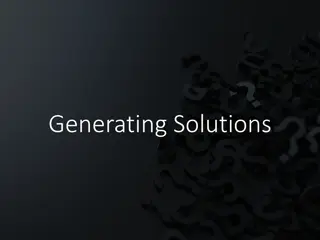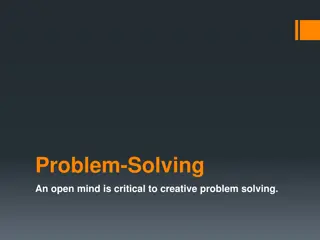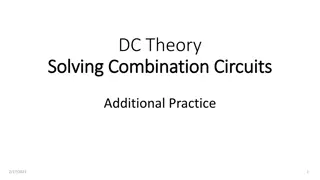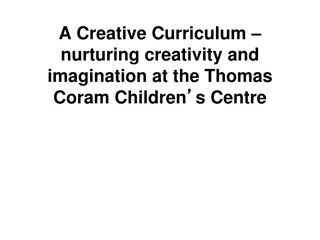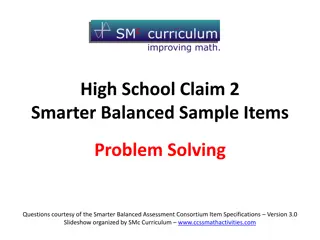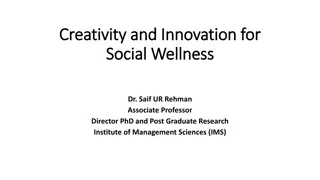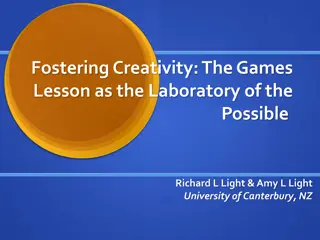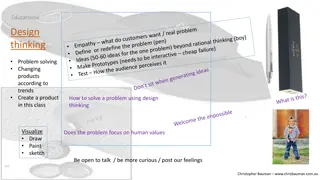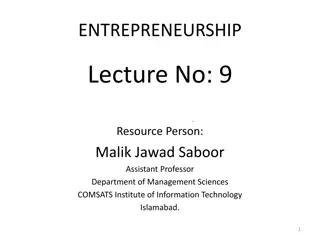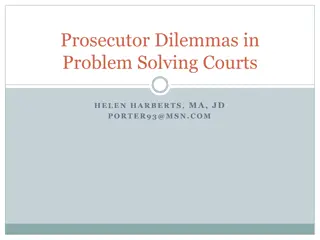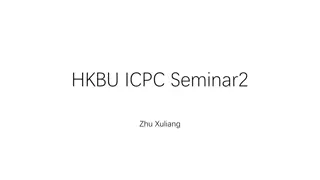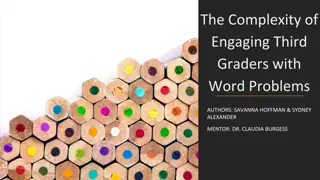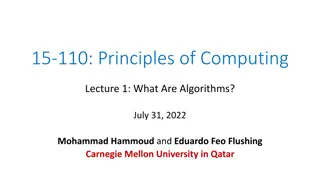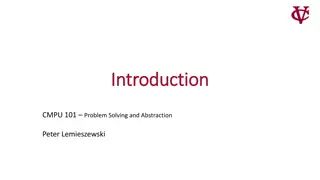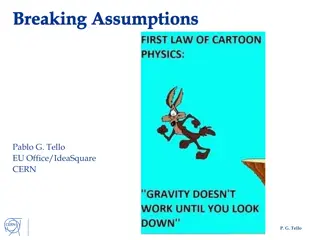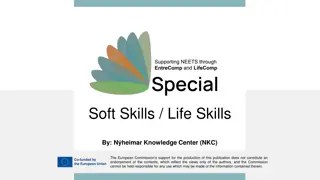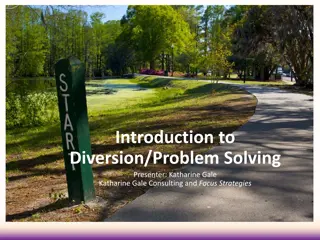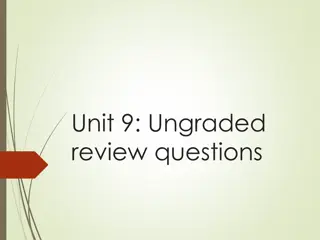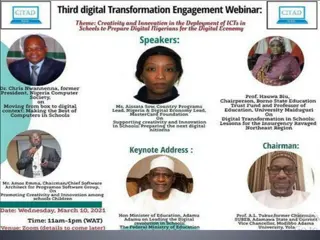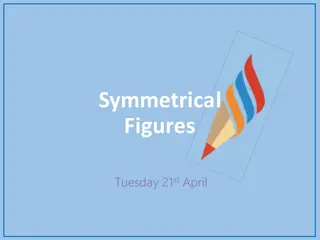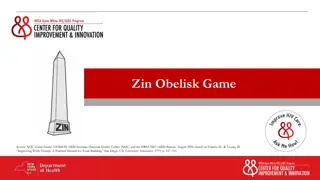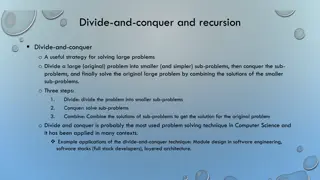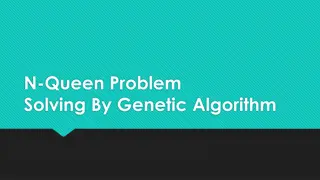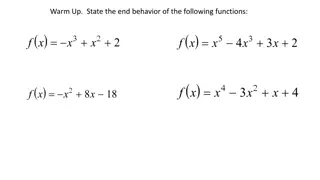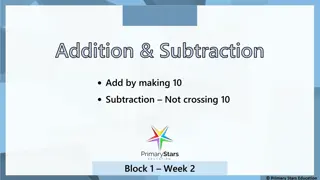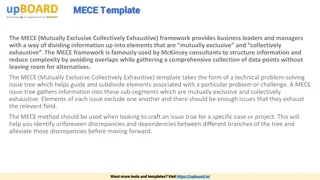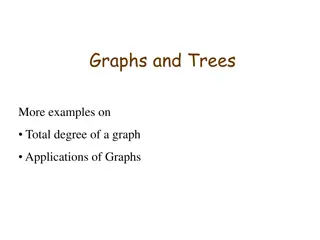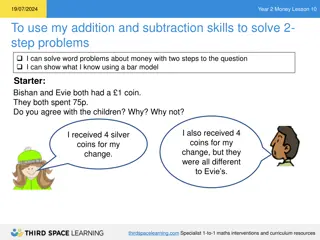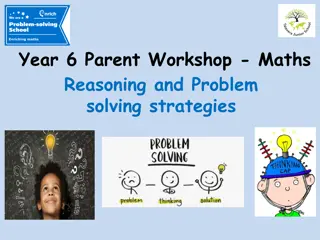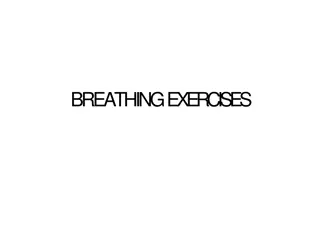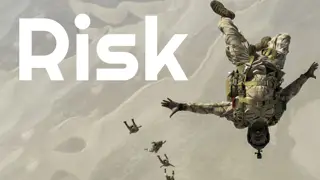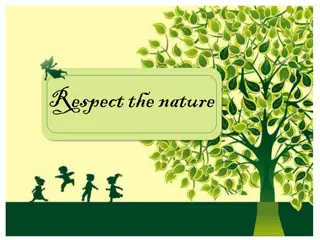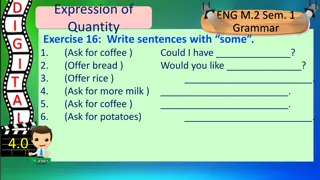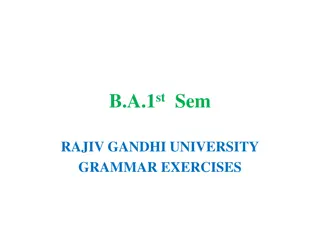Enhancing Problem Solving Skills through Creativity Exercises
Enhance problem-solving skills through creative exercises. Explore scenarios like tournament matches, cyclists' and bee's movements, and flat tire excuses. Learn about protecting creative work, approaching tower height, and lateral thinking steps to solve problems more effectively.
Download Presentation

Please find below an Image/Link to download the presentation.
The content on the website is provided AS IS for your information and personal use only. It may not be sold, licensed, or shared on other websites without obtaining consent from the author. Download presentation by click this link. If you encounter any issues during the download, it is possible that the publisher has removed the file from their server.
E N D
Presentation Transcript
C CREATIVITY REATIVITY E EXERCISES XERCISES There are 111 players in a single-elimination tournament. How many matches must be played to find a champion? Two cyclists are 30 miles apart. They approach each other at 15 mph (each is moving 15 mph). A bee flies back and forth between them at 40 mph. How many miles will the bee fly before the cyclists meet? Ben was 20 years old in 2000 but only 15 years old in 2005. How is this possible? 2
Changing wheel on car; when four lug nuts fall into sewer. How can he drive off? Four students were late for an exam. They claimed they had a flat tire, which delayed them. How did the instructor determine that they were lying? You want to publish maps and atlases; how can you protect yourself from pirates who copy/steal your work? 3
HOW TALLISTHE TOWER? How did you approach it? What did you measure? What was your answer? 4
L LATERAL ATERAL T THINKING S SOLVING OLVING HINKINGAND AND C CREATIVE REATIVE P PROBLEM ROBLEM Almost all of us need to (re-)learn how to think to solve problems 5
GOOD PROBLEM SOLVINGIS DONEIN TWO PHASES 1 1. . Creative Phase Creative Phase Perception and framing of the problem This shapes our framing of possible solutions (sometimes called the concept package) 2. Judgment Phase 2. Judgment Phase Development, evaluation, refinement, optimization of candidate/possible solutions 6
For various reasons almost all of us skip the first phase and jump right to the second phase Our formal education has probably dampened our creativity, which is the first and most important step in problem solving Problems are framed for us Emphasis on getting the correct answer Often the best of a set restricted by our framing 7
Most of our everyday problems have limited scope and do not need great creativity (should I buy a large coffee or small coffee?), so we can go directly to the second phase 8
CREATIVE PHASE The first (creative) phase is a lateral, divergent phase This is where we frame the problem/issue/potential solutions If the initial framing (concept package) is not good, then even optimal development of a poor concept package won t give a good solution By framing the problem in different ways, we can generate a wider variety of more creative potential solutions 9
In this phase we ask: Is it different? feasible? or is it better? ) Is it different? (NOT NOT is it We intentionally want discontinuity from idea to idea We want ideas/solutions that are as different from each other as possible 10
Bad framing: How can we make this product at lowest cost? This framing locks in and restricts our focus and options Better framing: How can we make a product of this type that customers will want? Or: How can we make this or a similar product more profitable? 11
Bad framing: What type of statistical forecasting model should we use to predict the next crisis? Better framing: How can we better predict the next crisis? Even better framing: What crises are likely to occur? What options do we have to prevent, predict, and/or adapt to each type? 12
JUDGEMENT PHASE The second (judgment) phase is a vertical phase We evaluate existing solutions and ask: Is it feasible? Is it better? Is it correct? We make changes to an existing solution and ask whether the changes improve the solution yes/no. We want continuity from one improvement to the next. Each step builds on the previous one. Vertical thinking takes traditional/obvious/ready-made ideas and builds on them vertical/logical (convergent) 13
To get To get good 1. We should first think laterally to generate ideas 2. Then think vertically to develop and refine them (use data and logic to evaluate, optimize, and execute the ideas) good solutions: solutions: You cannot look at something in a new way simply by You cannot look at something in a new way simply by looking at it harder the old way looking at it harder the old way 14
H HOW OWCAN CANWE WETHINK THINKLATERALLY LATERALLY? ? Brainstorming is very useful in a group setting We generate ideas, but no one is allowed to evaluate or criticize them for feasibility or goodness until after the brainstorming is complete Individually we can brainstorm by writing down ideas without considering feasibility, etc. Resourcefulness and money offset each other; the less money you have the more resourceful you must be to solve a problem, so maybe set a dollar limit 15
We want intentionally to create discontinuity of thoughts. We want to force ourselves to go back to basic assumptions of the problem With lateral thinking we seek NEW ways to look at the problem, not the BEST way. We can worry about best later. With lateral thinking we are allowed to be wrong . In fact, we want crazy, infeasible solutions, which might act as stepping stones to good problem solutions (called an intermediate impossible solution) 16
Any idea that at first glance doesn t look crazy isn t worth pursuing. - Albert Einstein 17
TECHNIQUESTO STIMULATE LATERAL THINKING Reversal Reversal Try to turn the obvious solution (or some aspect of it) upside down or inside out Basis for the Dialectic Method (Thesis, Antithesis, Synthesis) Propose idea, propose opposite idea, look for synthesis Synthesis is made up of good aspects from each of the first two without the bad; e.g., cellular production Use Opposite or Creative solution as an intermediate impossible solution 18
EXAMPLE Operations of a grocery or retail store Some basic aspects of running a profitable grocery or retail store Prices should be set at cost plus reasonable mark-up Customers should be treated fairly; all charged the same price Customers should have wide variety/many choices of products and brands Customers should be able to inspect physically and select the products they buy 19
Turn these upside down/inside out Reversal Prices should be set at cost plus reasonable mark-up All food/products should be free Customers should be treated fairly; all charged the same price Charge different prices to different customers 20
Customers should have wide variety/many choices of products and brands There should be little/no choice for customers Customers should be able to inspect physically and select the products they buy All food/products should be locked/chained to the shelves 21
R RANDOM ANDOM J JUXTAPOSITION UXTAPOSITION We can sometimes create new ideas by forcing ourselves to relate two seemingly unrelated ideas Try to frame the problem in a single word (noun or verb). Then randomly choose a word from a dictionary and think of ways of relating them. 22
Ex: Want to develop new confectionaries (chocolate candy) The random word is telephone Idea: You dial a telephone to select whom you want to call; you could create a machine where customers type in the tastes they like (nuts, sweet, lemon, etc.) and the candy is made with these features 23
This is a good tool for new product ideas Take two (service) products randomly from a list of services think of a way to combine them Book retailing/coffee house Education and hotels (or air transport) = executive centers Auto retailing and financial services = auto leasing Others? Tangible Goods Smart phones (phones, camera, computer) 24
How else might we use lateral thinking/ creativity methods? Business process analysis: make it more effective/efficient/useful Use a series of questions to force ourselves to think about the process in new ways crazy ways Force ourselves to ask Stupid questions Turn the conventional wisdom upside down 25
PROCESS ANALYSISAND IMPROVEMENT Elimination (What is done and why?) What is the true purpose of the task/job? Can this task be eliminated? Is it needed? How does it add value? Don t ask how we can speed up a repair or other activity, or how we can heat or cool something faster. Ask why does the repair, heating, cooling have to be done? Can it be eliminated? Fans in computers; AC in buildings DON T BE RESTRICTED BY FEASIBILITY at first 26
RE-SEQUENCE When do we re-sequence? Can we change the sequence or timing of tasks? Can this task be done before that task? At same time? At the heart of what is called quick set-up Think NASCAR Concert set-up Look for co-processing of tasks possibilities Shingo: changed process to weld then bend rather than bend then weld Had to overcome general belief that welds would not hold if the mesh was bent 27
Re-locate (Where is done?) Can we change where the task is done? Entire businesses are built around this: Taking services to the customer in the field Repair operations (e.g. car windows) Pet grooming Health care Centralizing Moving repairs to central location for greater efficiency and access to better equipment and labor skills Centralize inventories for better availability at lower cost 28
Who does it? Can someone else do the task as part of their existing job? Can they do it better or at less cost? Reducing hand-offs Should someone of higher skill or lower skill be doing this? 29
How is it done? Could it be done in a different way at lower cost or with better quality? Would new or different equipment help? 30
New process ideas? Track day-to-day activities and determine when a process is annoying Why do they do it this way? Why did they make it this way? Why can t it be like xxxxxx? Why can t it do xxxxxxx? 31
WHAT ELSE? You are creative -- everyone is creative in a specific area Creative thinking is hard work you must have the determination You must go through the motions of being creative it energizes your brain Your brain is not a computer -- it evolves There is no one right answer -- there are shades Never stop with your first good idea keep looking for better ones Expect experts to be negative it is not the way they think Trust your instincts There is no such thing as failure You do not see things as they are, you see how you are Always approach problem on its own terms from multiple perspectives Learn to think unconventionally This list was adapted from Michalko, M., Twelve Things you Were Not Taught in School about Creative Thinking, LinkedIn, September 3, 2016. Viewed August 1, 2018. Also considered Thinkertoys: A Handbook of Creative Thinking Techniques, Ten speed Press, 2nd Edition, 2006. 32


